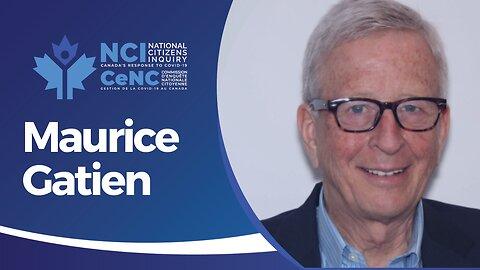Maurice Gatien, a lawyer and real estate agent, cautions people about surrendering their rights, “So when we give up rights, when we treat people as “the other,” as we saw, these are very troubling tendencies in society. And when these institutions of trust—like law societies, like colleges of physicians—go in a direction, a lot of people take it as a cue that, well, it must be all right. And there wasn’t the critical thinking that was applied.”
* The above video is being streamed via Rumble. Check back often as we continue to update the complete list of links to all witness testimonies in both video and audio/podcast formats.
[00:00:00]
Kassy Baker
Hello, Mr. Gatien. Can you please spell and state your name for the record?
Maurice Gatien
First name Maurice, M-A-U-R-I-C-E, last name Gatien, G-A-T-I-E-N.
Kassy Baker
And, sir, do you promise to tell the truth, the whole truth, and nothing but the truth this afternoon?
Maurice Gatien
I do.
Kassy Baker
Very good. Now, Mr. Gatien, I’m hoping that you can provide us with some background about yourself and how you came to be a witness at this hearing. I understand that you were called to the bar of Ontario in 1971, which is “lawyer speak” for saying that you are, in fact, a lawyer. Can you tell us a bit about your background and what’s happened more recently that might be of interest to this hearing?
Maurice Gatien
Yes, I graduated in 1969 from the downtown location of Osgoode Hall, since moved to York University, and it was a real privilege to be at their downtown location. I still return from time to time when I’m in Toronto to the great library. I’m always amazed at the contrast between the stacks of books, and they have high speed internet. So I can work and I can access the knowledge that’s on those shelves faster than I could if I were to stand up and go fetch the book. So it’s been an amazing evolution in the state of the law.
After I graduated, I returned to my hometown of Cornwall, practised for approximately ten years and, during that time, was involved in real estate primarily and contracts. I negotiated two large transactions in my last year there, which really left me with a lot of satisfaction. One was the purchase of the utility Cornwall Electric, and the other was the assembly for a large shopping centre.
I decided I would look in other directions and lived for the next 22 years from 1980 to 2002 in various big cities, Atlanta, Montreal, Toronto. And my last year 2001 and ’02, I lived in New York City. I spent a lot of time in Houston, as well. So it gave me a perspective of having a footprint in both large markets and small ones.
When I came back to Cornwall in 2002, I built a substantial practice and ultimately ended up representing people who needed representation with regard to the vaccines. Ultimately, in September 29th, 2022, I was suspended by the Law Society of Upper Canada, well actually, Law Society of Ontario now.
I found myself in January of 2023 addressing a group of the people that I had represented at a potluck dinner at a barn in Dunvegan, and it was heartwarming to be addressing these people who had shown tremendous courage. Some of them had been vaccine-injured, some of them had lost their jobs, and I told them about three situations that were interesting from my perspective. One was sort of a legend story of a farmer in North Glengarry by the name of Oded Saint-Onge who had been run over by a truck, he and his two cows, Isabelle and Annabelle, and he went to court to sue the large trucking company.
In court, the lawyer for the big Toronto law firm, head of litigation, asked him, “Did you not, Mr. Saint-Onge, say to the police officer at the scene of the accident, ‘I’m fine, see I’m fine’?” And the farmer started to explain and he said, “Well, I was taking my two cows across the road,” and the lawyer interrupted him again and said, “No, no, Mr. Saint-Onge, didn’t you say at the scene of the accident to the police officer, ‘I’m fine, see I’m fine’?” And the farmer again started with his story. And the judge interrupted and said, “I’d like to hear this man’s story, I’d like to know what happened.”
So the farmer explained that he was going across the road with his two cows, Isabelle and Annabelle, and the truck ran a stop sign and smacked into them and knocked him into the one ditch and the two cows into the other ditch. The farmer explained, “I was lying in the ditch. I was hurt; my ribs were cracked. I could hardly breathe and I could hear my two cows.
[00:05:00]
“They were moaning and groaning and in great pain. And the police came along, and he could see the cows in great discomfort. He took his gun out. He walked over to Isabelle, and he shot her right between the eyes. Then he walked over to Annabelle and also shot her right between the eyes. And he came over to me and he said, ‘And you, sir, how are you?’” And he said, “See, I’m fine, I’m fine.”
So we can see where there’s a form of intimidation that can take place, you don’t have to shoot everybody or fire everybody. When one or two people—or animals or whatever it happens to be—when something happens to them, we get a signal. And when I was experiencing my discussions, I had Zoom calls continuously throughout the preceding year or two with people from different walks of life, and it was pretty clear that there was a lot of intimidation.
One of the people I also met in my various travels and different business ventures, I met Pierre Trudeau in the late 1980s; he had left politics at that point. He had successfully brought the Charter and the Canadian Constitution back to Canada. And when one of my staff found out that Pierre Trudeau was going to be coming to a reception that we were hosting, Trudeau was his hero. He asked me if I could arrange for him to just shake his hand. I said, “Sure, I’ll ask when he arrives,” which I did. Mr. Trudeau very gracefully excused himself from the group of VIPs with whom he was chatting and spent ten to fifteen minutes with this employee, and I could just see the glow on this person’s face and how emotional they were about it. And afterwards, I thanked Pierre for taking the time and he said, “Well, he showed respect for me, and I was going to show respect for him.”
Now we transport that to 2022, in February of last year in Ottawa, and we saw that the son, Justin Trudeau, perhaps didn’t have the same respect for the small individuals, the average people, wouldn’t even walk across the street in Wellington Street in Ottawa to talk to anybody. I walked there from Cornwall in the middle of winter to address the [Trucker] Convoy, and he didn’t even walk across the street.
So when we look at intimidation, part of what brought me into this is, I received a phone call in May of 2021. At that point, one of my clients who owned a gym had been charged, and he asked me if I would also speak to a woman who had also been charged with him for attending a public rally. What had happened is that she had simply sung “O Canada,” the national anthem. When the person who was supposed to sing couldn’t make it, the speaker asked the crowd if someone would step up and sing the national anthem, and she did. And when I heard about this, I’m thinking, how could I not also step up and help her?
She was charged under the Reopening Ontario Act—which is really a lockdown act misnamed as the Reopening Ontario Act—pursuant to which she was subject to a $100,000 fine and up to a year in jail. So this hung over her head. We finally were able to get the Crown to agree to stand down from these charges in September of the following year. This hung over her head for fifteen, sixteen months, and it was not actually ultimately dismissed until December, so well over a year and a half to have this hanging over her head and also my client’s head. He also was charged, and these charges are still pending against some of the people, including Randy Hillier, who was one of the speakers that day.
So just, sort of, to come to terms with a situation where people are showing tremendous courage, I as a lawyer felt that I had to do at least as much—not as much as they were doing because they were putting their livelihoods on the line,
[00:10:00]
and they were experiencing a lot of bullying and intimidation. Because I was dealing with this particular matter, my name sort of got passed around. There weren’t a lot of lawyers who were stepping forward, and I would spend one or two evenings a week on Zoom calls, speaking with EMTs, teachers, firefighters, police, nurses from Brockville, from Hawkesbury, from Ottawa, from Cornwall, all coming back with the same stories of intimidation, bullying, HR departments releasing their names to indicate who was vaccinated and who wasn’t within their institution or their place of work.
So there were a lot of threats and intimidation, and I formed a company to raise some money for women’s shelters and to create goodwill towards these people because they didn’t know how to do it themselves. They asked me to be the director of the company because they themselves were running into all kinds of intimidation. Within 24 hours, my home address was doxxed online. I live in a small hamlet of 350 people and shortly thereafter, within about 48 hours, somebody came banging on the door at two in the morning. And then the harassment and intimidation continued. My car was stolen out of my driveway. I was assaulted at my office, and probably the scariest thing was one evening in October, this past year, my engine completely failed. I was on the 401 ramp, and somebody had put a contaminant in my fuel tank and it was a very, very scary moment.
So going back to February, I walked to Ottawa in the freezing cold to bring attention to the intimidation of lawyers, and I was joined on my walk—it was really inspiring—by three individuals, because I had to do it over three days. It’s quite a distance. All three were former members of the Canadian Armed Forces. Two of them were police, and one was a firefighter, all suspended for not being prepared to take the vaccine. Each of the three had served at least 10 years in the Canadian Armed Forces and different stages overseas, involved in “black ops” and things of that nature. And all three made the same comment to me, which was “it wasn’t over.” There would be more, and there was, as I experienced.
Kassy Baker
Mr. Gatien, I hate to interrupt you, but you rather glossed over how far a walk it is exactly from your home to Ottawa? Can you tell us?
Maurice Gatien
It’s 110 kilometres.
Kassy Baker
That’s right.
Maurice Gatien
And at the time, I was 74 years old. So it was quite arduous, but I was joined along the way by people from all different walks. One was a doctor who—he’s got very bad knees—was only able to walk about 100 metres, but I really appreciated it. And I also received more hugs. Lawyers don’t get a lot of hugs, so it was pretty emotional for me.
Kassy Baker
Can you tell us, in the immediate period around the time of the Convoy in February, what else was happening to you before and after that?
Maurice Gatien
Well, the one thing I noticed is there was a complete radio silence from the Law Society, also from the point of view of the College of Physicians and Surgeons of Ontario. No messaging about civility; no messaging about being nice to each other. We could disagree about things, maybe everybody could have a different perspective, but the attitude of civility was not being cultivated. It wasn’t being cultivated by the federal government as we saw with some of the interviews from our Prime Minister about people being racist or misogynist. I never heard those topics come up, and I spent hundreds of hours with people and those topics never came up. It was about health; it was about the pressure at work; it was about family. It was certainly not about misogyny or racism. I never saw it.
I did see one situation when I came to Ottawa,
[00:15:00]
not when I walked up here. But another time I came on a Saturday, and somebody had a Confederate flag. They were the only person wearing a full-face mask. People were very, very civil to this individual, basically saying, “Please leave, you don’t fit here with that messaging, please leave.” There was no bullying of them; it was just a gentle, “Please leave.” He got edged to the side of the crowd where there was a TV camera to capture this messaging, which was really out of keeping with the whole tenor of the convoy protest. I was here four times. And each time, I can say that the atmosphere was joyous and positive, and the people were wonderful.
Kassy Baker
Now, I understand you have a PowerPoint presentation for us [Exhibit OT-9]. Would you like to take this opportunity to set that up?
Maurice Gatien
Well, I think it’s supposed to be—
Kassy Baker
Thank you.
Maurice Gatien
So one of the things I’d like to talk about is the bold lie technique. When I was working in Montreal managing office towers and shopping centres, one project was an office tower that had defaulted on its mortgage, and one of my staff went around with the lender. It was a New York-based lender. It was their largest defaulting mortgage in North America, so it was a very significant file. And when they got to the building and went around to different office suites, there were signs on some of the office suites. They’d open the door. There was no furniture. There was no equipment. There was nothing. And in other suites, there would be someone there. But they would look at the rent roll and say, “Well, those are not the terms of my lease.” And what was evident was, it was either a combination of ghost tenants or leases that were just not the same. And yet the bank, a very sophisticated bank, had lent, at the time, $86 million. So it was a significant amount of money. But it was an example of a Bold Lie.
My next-door neighbour, at the time we’re living in Montreal, was a TV producer, and he wanted to do a TV program about a forensic accountant who went around discovering fraud, and he asked me to help him with this. So I ended up, even though I was a small-town lawyer and am now managing large real estate projects, ended up becoming quite knowledgeable about fraud.
And the most interesting fraud that we came across was after the First World War in Paris. This fellow had contrived a scheme whereby he had gotten a printer to produce a very fancy letter head from the Ministère de l’Approvisionnement, Ministry of Supply and Services, which he had sent to the five largest contractors in Paris, basically saying, “I’ve got a very confidential project. I cannot meet you at the ministry offices. I have set up a suite at the Hôtel Crillon”—which is a very fancy hotel in Paris—“and your designated time . . . .”and each of the contractors had a different time slot, “Please come and we can discuss this confidential project.” Of course, all five bit and all five showed up.
The pitch was the following. He said, “Once you know what I’ve got to discuss with you, you’ll realize how you must keep this very secret. The government is looking under every manhole cover. We need money. We’ve come out of the First World War owing a lot of money. And we want to disassemble the Eiffel Tower and sell the scrap steel. However, I can probably steer this contract to you if you can come back a week from today, no obligation, with an envelope full of”— I forget the amount, 100,000 francs, 200,000 francs, whatever the amount was. Of course, they bit, and this guy absconded with the money and everybody laughed. But no one wanted to fess up or prosecute this individual because it was extremely embarrassing and very clever. But it showed the originality and the planning that goes into the Bold Lie. That was the phrase that this TV producer and I came up with: not just the lie, not the Big Lie—but the Bold Lie.
And we saw the Bold Lie with Bernie Madoff with—I just looked at the amounts today—it was about $65 billion U.S. that he was able to pull out of investors, and they only got back maybe about 20 of that.
[00:20:00]
The rest just disappeared into a massive Ponzi scheme.
The 2008 mortgage funding fraud, which took place, had gone on for a couple of years in the United States. Now as a lawyer, we know that a document called a mortgage is something secured on real estate. But if the mortgage is for $500,000 and the house is worth $400,000, you can still call it a mortgage, but now it’s become a hybrid: it’s now a partly unsecured loan. What the banks did at the time is they bundled hundreds of millions of dollars of these types of instruments and sold them to unsophisticated investors and sometimes, also, very sophisticated investors. And when this finally imploded in 2008, as it would, people lost many dollars, huge amounts. Several films have been made of this and books, and everybody could see it coming except the investors because they were buying in to the Bold Lie: they were buying something safe called a mortgage and a mortgage fund.
Since that time, we’ve seen these things repeated. There’s been Bre-X, Nortel, FTX. They’re all the same model where it’s a Bold Lie: you’re going to make a lot of money. We wondered, the TV producer and I, tried to analyze things as to why the Bold Lie works and we came to the conclusion, it works for two primary reasons. One is most people have a sense of morality. Most people would not exploit the other person to their detriment. The other aspect is practical, which is most of us also don’t want to face the consequences of going to jail. We are concerned for ourselves, our families but the main one, though, is that moral inhibitor, which is we don’t want to exploit other people to that extent. But the Bold Lie is the foundational element to a lot of things that have transpired.
So going from the Bold Lie, okay, we can also see that with COVID— The way I would like to describe it is that there’s two Bold Lies that were coexisting at the same time. So to get a sense of it, I’d like to take you on a bit of a journey of imagination. I’d like you to think of March 2020, and we’re in the Mediterranean. We’re on this beautiful yacht, and there’s Kassy, you, me, at a table. We’re on a yacht to celebrate the profits from a company, and we’re going to call it Geyser Pharma. There’s no such company as Geyser Pharma, so I’m not suggesting, aiming at anybody. And we’re at our table. There’s a gentleman, it’s a fictional person by the name of Gill Bates. It’s a situation where there’s the finest champagne being poured into the finest crystal glasses. There’s caviar, there’s the finest shrimp, and there’s a classic trio flown in from Milan to play for our entertainment. And off in the distance, we can suddenly hear the voice of somebody who’s crying for help and someone who’s drowning.
So Kassy, you and I would probably jump up, and we would look for some rope to throw to this drowning person. And Gill says, “Well, don’t worry. I’ve got it.” So he goes up to the side of the wall and picks out a rope. He mentions to us, he says, “Well, this rope cost $1.50 a foot, but I’m going to see if I can get this guy to pay $30 a foot.” And he goes to the railing and starts to negotiate and, ultimately, in order to help the negotiations, says, “Gee, I think I see some shark fins there. It could be dangerous.” And you could just hear the person crying.
That’s the setup for a Bold Lie: when we’re desperate, when we’re scared, we’re more likely to make bad decisions. So with COVID, there were two Bold Lies. One was, you’re going to die. COVID will kill you. And we’ll go into some of the reasons why that was not true in our area and in our province. And the second Bold Lie was, only the vaccine will save you. No other strategy,
[00:25:00]
don’t worry about losing weight or taking vitamin D or whatever. Nothing was offered as an alternative except the vaccine. So it’d be like going back to the fellow in the water drowning and not telling him, “Oh, there’s a sandbar five feet away. If you just go over there, you won’t have to worry about paying $30 a foot for some rope.”
So when we looked at the situation, we saw no promotion of good health. The gyms were closed. Liquor stores remained open. And at the same time, with all the stores, the small businesses that were closed, it was a massive wealth transfer. When I was choosing a photo for this particular slide, I could not get all of this yacht—this is the new yacht that Jeff Bezos just took delivery on a couple of days ago. Cost $500 million. It’s the length of a football field. In recent weeks, I’ve also noticed that yachts are backordered 30 months. So, Kassy, even if you made a billion dollars, I’d have to tell you bad news: you’re going to have to wait for your yacht. Ferrari SUVs are back ordered till 2026. And there’s been a whole raft of new billionaires that have achieved this status in the last three years. It’s been an amazing transfer of wealth. And I’ve had people coming into my office, restaurateurs in particular, have been decimated by what happened in the last three years.
So when we look at the numbers, and it was very interesting for me in a small town to be in touch with the numbers. I speak to other lawyers on a continuous basis. I personally—and I’m in an age group that would be very much in the right profile—I personally, after three years, don’t know anybody who’s died from COVID in the Cornwall area. I ask other lawyers, “Well, do you know anybody who’s died from COVID?” And they’ll say, “Well, no, not really.” “Have you noticed the surge in your probate files?” “Well, no, not really.” “Have you been called to the hospital to do a will or a power of attorney for somebody who’s imminently going to be dying from COVID?” The answer has been, “Well, no, not really.” So after a while when you hear enough anecdotal evidence, it becomes statistical.
Partly because of my background in managing large real estate projects, I became quite acquainted with software and statistics. And one day, there was an article in the local paper about the COVID deaths, and there was a link on their online version to the Eastern Ontario Health Unit database, which I clicked on. I ended up in a database of about 6,000 scrambled pieces of information, which I organized into 10 lines. Basically, by decade of life of each of the people who had theoretically died from COVID. So, from 0 to 10; 10 to 20; 20 to 30; 20 to 40. Under 40, there was not one single COVID death. So I was kind of amazed with that fact because the schools were closing. There was panic. And it was, to me, a piece of good news that should have been out there instead of being suppressed and buried in this very scrambly database.
So when I looked at this, and also looked at the profile of the other, there were only two people between the ages of 40 and 50, and most of the deaths were from 70 to 100, with most of those being from 80 to 100. There was no listing of comorbidities. Yet I knew from all my reading that a lot of COVID deaths were accompanied by people being overweight, people having had strokes or other problems.
In March of 2020 on my way back from—my wife and I were in Hilton Head—I had read that COVID affected the pulmonary system. So I downloaded a book on breathing. I started doing breathing exercises.
[00:30:00]
I immediately experienced better sleep, felt better. And I kept waiting for that big, big government push on improving your breathing. That big push never came. We’re three years later, and it still hasn’t arrived. I went through a number of evaluations of different initiatives that could have been taken by government. My daughter and I drew up a list, A to Z, whether it was breathing, weight loss, reducing alcohol consumption, you name it. There was nothing that was done to encourage better health.
So this vacuum created this anxiety that the vaccine was the holy grail. The vaccines were going to save everybody, but nobody had done anything to mitigate this big fear. So when I looked at the numbers, I looked at numbers, not just for the Cornwall area—I just took one at random because one of my friends was from Niagara—I looked at figures from Ottawa, Toronto. All the figures were under four one-hundredths of one per cent. I’m not a statistician, but by the same token, I’m not a journalist. But I would have thought that the newspapers would have been filled with this good news.
There was a day, a couple of Februarys ago, when I was looking at the weather channel predictions and there was a beautiful blue sky day, quite cold, but good day for cross-country skiing or snowshoeing. At the top of the weather channel prediction was a big red bar warning me of snow squalls. So I clicked on it, and it was warning me about snow squalls around Lake of the Woods, which is about a thousand kilometres from where I live. So I took my chances, and I went out and had a wonderful day of snowshoeing. The next day, I also looked at the weather channel. It was a Sunday and again another blue sky day. And I looked at the weather channel radar map, it was one of those polar highs that covered all of North America, and there was no clouds, there was nothing, it was just going to be beautiful everywhere. But the red bar warned me about solar storms on the planet Venus. Again, I took a chance, and I went out and had a wonderful day again.
So in the media, it seems there’s an overemphasis, even on something as fundamental as weather, an overemphasis on the negative and on alarming us. When I grew up, the newspaper in the top right-hand corner of the front page would have two, maybe three lines about the weather. Things like, “It will be cold tomorrow.” That was it. So we’ve now put ourselves in a position where the media are constantly bombarding us as much as possible it seems with negative news as opposed to, you know, “Get out there, enjoy yourself, be positive.” And I’ve turned it into a game for myself when clients come into the office and I’ll ask, “How’s it going?” And they’ll say, “Oh, it’s supposed to rain tomorrow.” So, I always know the weather forecast. I always know that the rain will end. And I’ll shift the conversation to, “Gee, it’s supposed to be nice on Sunday. Do you think you could go and play some golf?” And all of a sudden, the conversation has turned to something positive. And I feel that it’s a fun thing to do, but the media doesn’t seem to have that optic on things—it’s how do I make people anxious? And the weather network now has it set up so that it’ll say at the bottom of the screen, “This will refresh in 30 seconds, do you want to hang on and see?” And I’m thinking to myself, “What could change in 30 seconds?”
So we’re always on this edge of anxiety. And COVID came along and amped that up tremendously, and we were bombarded with bad news, bombarded with statistics all the time. It got to the point where I had to turn my radio off. I live about 20 kilometres from Cornwall, and I just had to stop listening because it was just always, always panicky.
One of the things I talked about when I was at that potluck supper—which I have very fond memories of in a barn in Dunvegan. I wouldn’t call it the big time of the speaking tour in Canada, but certainly in terms of satisfaction was there.
[00:35:00]
Talked about the Charter of Rights. I talked about it when I addressed the crowd at the Convoy. And we tend to forget that our rights originated with something called the Magna Carta, which was signed in 1215 after a war against the king, who was a very tough king at the time. He died the following year, and the Regency Council tried to renege on the Magna Carta. It ended up having to have another war, and it was re-signed and ratified in 1217. And what most people don’t realize is, it only applied at the time to 25 people, 25 lords and barons, and they were given a very short list of rights. One of the rights was the right against arbitrary imprisonment, which would be equivalent to being stuck in a home imprisonment, which we saw with COVID, “shelter in place,” they called it. But it was really home imprisonment. And the other was the right against arbitrary taxation, arbitrary decisions being made. So it took until 1911 for the Act of Parliament to be passed in England whereby the House of Lords could no longer veto bills from Parliament.
So almost 700 years have to go by and every year the rights got a little wider. And I’m sure after 1217, some of the lords went back to their fiefdoms and there would have been somebody tapping them on the shoulder saying, “Well, my Lord, you have certain rights, can we have some too?”
When we looked at the history of this situation as well, it was something that seemed so incremental, it took so long. In the 1600s, there was a concept that evolved under the first King Charles called the “divine right of kings.” In other words, “My king is plugged into God, you have no right to question the decision.” And at the time, the king had no problem getting reports and studies and scholarly works to support the notion of that, just by promising an earldom or a manor house to somebody. And things haven’t changed a lot since that time. If you want a report, and I do remember when I was working for this large company, we paid $250,000 for a report, and the president of the company picked it up, looked at it and said, “huh, $250,000 to tell me I’ve got a nose in the middle of my face.” When we look at the studies and reports that were surrounding COVID, who paid for it was certainly going to determine a lot of the outcome of what the report was going to say.
So when we look at the Magna Carta, what evolved in Canada, it wasn’t until 1982 that we got our Constitution repatriated; the Charter of Rights was implemented by Pierre Trudeau. And in literally a week, in March of 2020, we lost all those rights. Parliament did not sit; it stopped sitting. And I’d like to joke to my friends, “Well, the Ottawa Senators have not made the playoffs in a while. The arena should have been open; there could have been plenty of social distancing, they should have met.” But by not meeting and by defaulting on any discussion, all of a sudden, a handful of people were making all of the decisions for millions and millions of Canadians. We had no outlet. We had no way to express any of our concerns.
So when we look at the Charter— and it was interesting for me to also look at the history of marketing and advertising. Because what happened over the hundreds of years of evolution of the Charter of our rights, something happened in the 20th century. From 1900 on, it really evolved after the First World War. During the First World War, we saw the first forms of advertising with any sophistication. So think of how much it would take to persuade somebody to go from New Zealand or Australia or Canada or Newfoundland,
[00:40:00]
to go into the fields in Europe and to live in trenches for months at a time. And at the sound of a whistle, to jump out of the trench, and because the colonials were the lucky ones, to lead the first charges. And nobody had told them, by the way, the machine gun has been invented. So they were being persuaded for glory, for God and country, to give up their lives.
So when the 1920s came around, the advertisers of everything from Pepsodent toothpaste to whatever, realized, wow, there’s something available to us to push our products. Radio came along, then television, then the internet, telephones. Now with social media, we are constantly bombarded by messaging, and these expanding platforms have meant that we can almost find no safe harbour. I try to get out snowshoeing or cross-country skiing, get out into nature, if only to shelter myself from this constant bombardment. Our bandwidth, if you will, of available brain power to deal with everything is getting increasingly compressed.
There were some experiments that I read about and the first one I read about— I had actually read about it in 1965 when I was at Carleton University. We had to take a mandatory course in psych 101, and they were called the Milgram experiments. The Milgram experiments were designed to explore the proposition about people following orders. At the time, a fellow by the name of Adolf Eichmann had been detained by the Israelis in Argentina and had been brought for trial. His basic excuse, even though he put millions of people to death running the concentration camps was, “I was just following orders.”
In the Milgram experiments, which were conducted at Yale University in 1961, Professor Milgram set it up so there were three people involved. One was called “the learner” and that person sat in a chair with electrodes and was electrified. It really wasn’t, but it looked like it was, and it contained an actor who sat in it. The second person was called the “person of authority,” wearing a lab coat and clipboard, and he would be telling the person upon whom the experiment was going to be conducted that they would have to give the learner some electric shocks. You’ll notice that one of the settings on the electric shock board was DANGER: SEVERE SHOCK. So the person who was controlling the experiment, controlling the amount of power, was being alerted that this could cause harm.
The professor asked his students to estimate how many people would dial it up right to the top. Most people figured, well, one, maybe 3 per cent, there’s always somebody who’s a bit of a jerk out there. The actual number turned out to be 65 per cent; 100 per cent of the people were willing to give at least a mild shock. And the actor, by the way, in the other room, was trained to yell in pain as the shocks increased. So it was pretty amazing that somebody would suspend their judgment, suspend their critical thinking if someone in a lab coat, someone of authority, would tell them to do something.
The next set of experiments—in the 60s, there was a TV show called “Candid Camera,” and it evolved out of that—and they were called the elevator conformity experiments. It consisted of a person getting on an elevator, and there would be one person on the elevator initially, and they’d be facing the back wall. Almost everybody would face the normal way: they’d pivot, they’d look at the door, they’d look at the buttons. But once they got up to five people on the elevator, 100 per cent of the people would pivot and face the back wall, as well. That’s the pull—the gravitational pull that we experience from the tribe—from people around us.
Now, if there was a sixth person on the elevator facing the right way,
[00:45:00]
a person would feel encouraged to use their critical thinking, would feel encouraged to be separate from the crowd and would face the right way. So it just shows our inclination to abandon our judgment, if you will, if there’s enough people doing something. We saw this happening during COVID many, many times.
The third set of experiments were conducted in 1971 at Stanford. They’re known as the Stanford prison experiments, and it consisted of 12 students who were designated as prisoners and were put in prison garb and 12 who were designated as guards. They actually built some cells in the basement of the psych building, and the experiments were to be conducted over a period of 14 days. They had to suspend them after six days because the guards were getting out of control. They were becoming abusive and what happened is that once the first guard started to go over the line, that would encourage others to do the same and before you knew it, they had to suspend the experiments. That shows that you need rules. The rules have to be thought out before you do something. Trying to implement rules on the fly doesn’t work very well. You try to implement rules when you’re calm, when you’re rational, not when you’re panicked.
So what we saw during COVID was the opposite of these things: we saw rules invented on the fly; we saw rights being suspended; we saw the tribe, the herd basically running and influencing each other in their panicked state.
Foundational documents like the Charter of Rights—the right to assemble, the right to speak—became suppressed; censorship became the norm, and even to disagree became in and of itself almost demonized. I can’t tell you how many evenings I spent on Zoom calls with people who were upset: who were threatened, who were worried. They’d lost friends; they’d lost family, just for expressing an opinion. So we did engage in a form of groupthink, which from a lawyer’s perspective were very troubling because under our Charter of Rights, we have the right to express our thoughts and opinion.
Now one of the things I also noticed in my research, in 1930s Germany, there were a lot of parallels with what we saw, and people were reluctant to state it. But one of the things I found alarming in 1930s Germany is group after group were mobilized and purged from their ranks people of Jewish background. The first group to do so were judges and lawyers; the last group to do so were midwives, presumably because they valued all life. So in 1933, first group, judges and lawyers. And after that, quickly after, followed doctors, veterinarians, architects, engineers. It’s pretty amazing that they were able to do this. And one of the other things I found troubling was I looked for any comments; I looked for any writing from the 1930s from Canadian lawyers, Canadian judges, American judges, American lawyers. Nobody criticized what had occurred, and yet we know, it led to some very, very bad outcomes.
So when we give up rights, when we treat people as “the other,” as we saw, these are very troubling tendencies in society. And when these institutions of trust—like law societies, like colleges of physicians—go in a direction, a lot of people take it as a cue that, well, it must be all right. And there wasn’t the critical thinking that was applied.
As lawyers, normally, we rely on evidence. And as you saw, with a death rate of four one-hundredths of one per cent, with almost a negligible change in the number of probate files and whatnot, where was the evidence?
Kassy, to your point, when we were talking earlier, where were the lawyers? We, I guess, unfortunately,
[00:50:00]
were subject to the Milgram experiment; we were subject to the elevator conformity experiment; we were subject to the Stanford prison experiment without being aware of it.
As far as I’m concerned, these things, these experiments should be taught in our ethics courses. They should be taught in medical school, in law school, as part of our ethics courses, and we should never forget how vulnerable we are and how important it is to have these foundational concepts always borne in mind. That’s how important they are. They are the guardrails against bad decisions.
The last observation I’d like to make about this aspect, too, is sometimes when I go to Toronto, I will buy all four newspapers. A story, it could be any story, might receive a favourable treatment on the front page of the Globe, might be front page of the Post, will have a different slant on it. It might be on page 37 of the Toronto Star; it may not even appear in the Toronto Sun. And by the way, the story, what I’ve expressed, could just as easily be the other way around. And sometimes when I engage people in discussion about this, they read the same newspaper every day. And they don’t realize what a silo they have been placed in and how they have been compartmentalized from getting a range of ideas, a range of thought. So it’s important to basically get your news sources from more than one place because, otherwise, it’s very easy to divide and conquer if we’re in compartments.
I need to go back a bit here, sorry. One of the things I do want to talk about is the clown deals. I’ve done a lot of negotiating and large deals, small deals. One deal I did was for a fellow who came to our house—he arrived on his riding lawnmower because he didn’t have any other way of getting to our house—and he was trying to buy a $5,000 piece of property that his house sat on. And I worked out the deal with the church that owned the land whereby he could work off some of the purchase price by mowing the lawn at the cemetery. And the pastor and I joked about the “art of the deal.”
So when we look at deals, most deals start out—if you think of, in your mind, a table—the contract, the proposed deal, will be in the centre of the table, and typically it will migrate a little bit to one side or the other. It might be 50-50, in most instances; it might be 52-48. At 55-45, most deals start to fall apart. If the person is asking too much or if the terms are too onerous, something happens to break the momentum of the deal. If you have a million dollar house and you want 10 million for it, that won’t work. And if somebody offers you $100,000, that also won’t work; you’ll walk away. Most lawyers also understand that if you ask too much, people won’t want to negotiate with you. And if you ask too little, nobody will want to use your services because you’re not in the middle of the table and you might refine the deal. When we look at the vaccine supply contracts, they did not end up in the middle of the table.
The other thing that I would mention with regard to most deals, if you look at TTC [Toronto Transit Commission], you look at the OTC, you look at Hydro, where there’s a potential for abuse of pricing and for the benefit of people, it makes more sense to own it yourself. Just like it sometimes makes more sense for a company to run its own trucking fleet. If the trucking costs are too high by externalizing it, they’ll bring it inside. So I’ve read articles indicating that vaccines may be with us for a long, long time. Why aren’t we making our own vaccines? Why are we passing on these huge profits? When I looked at the profits for Pfizer
[00:55:00]
that increased to $35 billion in 2022; it’s an enormous amount of money to transfer to a private corporation.
The other thing we should be looking at is the history of Big Pharma. I like doing research, and one of the things I notice is that Big Pharma has paid massive fines in the past. Nobody has ever gone to jail. Even something as bad as the oxy crisis in the United States, which they estimate killed 60,000 people, the company there, Purdue pharmaceutical, the family that owns Purdue, the Sackler family, their only consequence is that they had to resign from the board of the Metropolitan Museum of Art in New York. I know that tickets to the Met Gala are hard to get, but it seems like that would be not exactly the penalty you’d expect of 60,000 people that died as a result of a product being sold. They kept about $10 billion out of the $18 billion that they made. When we look at Pfizer, for instance, has paid $1 billion in fines in the past, for lying, for misrepresenting their products.
And the other element that really troubled me in all of this as a lawyer, when I looked at the self-testing aspect of the deals that were put together, can you imagine hiring a lawyer who graduated from a law school where people graded their own exams? I would expect that everybody would say—anybody graduating from such a school would say, “I was at the top of my class; I tied for first.” And then just to have that law school say not only do people self-mark their exams, but instead of a three-year course, you can get it done in 90 days. So on its face—preposterous, preposterous—and yet, this is what transpired with the vaccines in terms of testing.
So when we look at the “clown deals,” and again, keeping in mind how a contract normally is in the middle of the table, these are the benefits that were accrued to the vaccine makers: There were massive amounts paid to them for their R&D. All of the vaccine jab clinics were paid for by the taxpayer. All the marketing costs, all the massive advertising was paid for by you, by the taxpayer. There was massive support on air, on radio, on TV, everywhere, and censorship as well of anybody expressing a contrary point of view. The vaccine manufacturers had no liability for their product. If it didn’t work, they didn’t bear any of the costs. There were no outlets—like I’ve looked at the various health unit websites, there’s nowhere to file for a vaccine injury. There’s no information about how to communicate with anybody about a vaccine injury. There were mandates that were imposed that put a person at risk of holding onto their job, and I know from having talked to people who had come into my office, people with mortgages, people with families to feed, they didn’t have huge savings. They were at risk, and they were subject to enormous stress and pressure as a result.
The doctors as well were placed in a position of—how would you describe it—duress, suspension of their licence if they gave a vaccine exemption certificate. I had one woman call me, she was five months pregnant. She had had two very difficult pregnancies. Her children were now eight and 10. She herself had almost died from a vaccine given to her when she was eight years old. So here she was wondering about placing her unborn child at risk, and herself.
[01:00:00]
And the irony was that if she had wanted to have an abortion, it was my body, my choice, was the mantra. But if it was about whether or not she should take a vaccine, it was a totally different mantra.
In discussing these clown deals, and I’m being generous to call them clown deals. Because I wonder if there’s an association of clowns somewhere and one of them wanted to get his driveway paved, he’d pay a certain price. But if he had a thousand other clowns who also wanted to get their driveway paved, and they said to him, “Do you think you can get us a better price?” We know he’d get a better price. So we had thousands of vaccines, millions of vaccines being purchased with no discount, no claw back, no price adjustment if they didn’t work. It was all, all full price. And at different times, there were also vaccines being thrown away because they’d become outdated.
So there was a tremendous amount of waste. And, normally, in a deal, again, going back to contracts, if somebody’s putting up all the money, they get stock options or they get some kind of profit sharing or they get a royalty, something for the taxpayer. Instead, we got nothing. So again, I’m probably insulting clowns to be calling these clown deals. I don’t know what else to call them. Perhaps hostage deals would be close, as well, because people were feeling like they were being held hostage.
Kassy Baker
Mr. Gatien, thank you very much for everything that you’ve testified to today. I’m aware that we are officially out of time and I just wondered if you perhaps had another something else quite pertinent that you wanted to add and if not, I mean everything you’ve said has been quite—what’s the word I’m looking for—not intriguing but very compelling. Do you have anything final to say or should I go to the commissioners?
Maurice Gatien
Well, I would like to just perhaps leave on this one anecdote. Because it’s been difficult but, at the same time, very rewarding. I was assaulted in my office, and I’m fairly wary. This is in February; this is what caused me to walk to Ottawa. The following week, I was at the grocery store in Lancaster—it’s a little town of 600 people—and I noticed that this one person was paying attention to me. They were wearing a mask, and I was kind of aware, a little bit anxious, perhaps. I paid for my groceries. I went out to the parking lot. As I was putting my groceries into my vehicle, this gentleman came running up to me and I was momentarily taken aback. But he took his mask off and he said, “Can I give you a hug?” He said “My wife almost died from the first shot. She was feeling suicidal. You don’t know how important she is to me, to my children, and I just want to thank you.” Moments like that made it possible for me to live with all of the things that I’ve had to deal with in terms of the threats and the intimidation. And people like that are to be cherished and honoured. As much as it’s been a challenge, I just tell my friends I’m fine.
Kassy Baker
Are there any questions from the Commissioners?
Commissioner Kaikkonen
At the beginning of your presentation, you contrasted Trudeau Senior and Trudeau Junior. I’m going to add an extra contrast. If it was Trudeau Senior, Pierre Elliott, who was in Parliament right now, I’m quite sure that he would have wandered down here himself or at least sent some of his MPs down this way to see if any of their constituents were in the room and testifying at some point since we are in Ottawa. Seeing that it’s Trudeau Junior, Justin, that’s in Parliament, I would like to add that he has censored his MPs, and his MPs don’t think that we’re valued enough to come down the road, down the street, to see who’s in the room,
[01:05:00]
whether it’s some of their constituents. So there is that contrast.
The other thing, as you mentioned, the Milgram experiment. Some of us do teach at every opportunity those experiments to any youth or students that we have and have done so consistently, as well as encouraging people to take the Tri-Council Research Ethics course, which is two hours online. And what I’ve found is that when I speak to my colleagues and my peers as to why they don’t do the same, it’s because they don’t think that anybody is ever going to come for them when this lets go.
I thank you for your testimony, it was very intriguing, but it was also very enlightening. I hope someone’s listening that can make a difference in people’s lives. Thank you very much.
Maurice Gatien
Thank you.
Kassy Baker
And I would also like to thank you on behalf of the Inquiry. Thank you very much.
[01:06:10]
Final Review and Approval: Margaret Phillips, September 6, 2023.
The evidence offered in this transcript is a true and faithful record of witness testimony given during the National Citizens Inquiry (NCI) hearings. The transcript was prepared by members of a team of volunteers using an “intelligent verbatim” transcription method.
For further information on the transcription process, method, and team, see the NCI website:
About these Transcripts
Credentials
- Ontario law school grad 1969
Summary
Mr. Maurice Gatien, a lawyer and real estate agent, gives an indepth historical and current picture of the COVID 19 situation viewed from many different angles. He was involved both professionally and personally, even to the point of suffering threats and abuse. Maurice walked 110 kilometers from his home in the Cornwall area to the trucker convoy in Ottawa over a three day period in the February cold, at the age of 74 years.
Mr. Gatien was representing citizens who had received fines for attending rallies until, in September of 2022, the Law Society of Upper Canada suspended him. Maurice uses stories to illustrate the manipulation that was used on people to make them follow the government narrative. He educates us about the bold lie, the fear tactics and the clown deals. Inspite of the threats and intimidation he has had to deal with he tells his friends he is “just fine”.






















